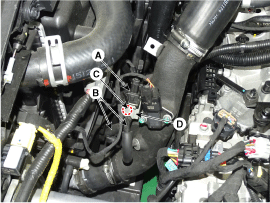Hyundai Kona: Engine Control System / RCV Control Solenoid Valve Repair procedures
| Inspection |
| 1. |
Turn the ignition switch OFF.
|
| 2. |
Disconnect the RCV connector.
|
| 3. |
Measure resistance between the RCV terminals 1 and 2.
|
| 4. |
Check that the resistance is within the specification.
|
| Removal |
| 1. |
Turn the ignition switch OFF and disconnect the battery negative (-)
terminal.
|
| 2. |
Remove the air duck (A).
(Refer to Engine Mechanical System - "Air Cleaner")
|
| 3. |
Disconnect the RCV control solenoid valve connector (A) and vapor hoses
(B).
|
| 4. |
Remove the RCV control solenoid valve (D) by loosening the mounting
bolts (C).
|
| Installation |
|
| 1. |
Install in the reverse order of removal.
|
 RCV Control Solenoid Valve Schematic diagrams
RCV Control Solenoid Valve Schematic diagrams
Circuit Diagram
Harness Connector
...
 Fuel Pressure Control Valve (FPCV) Description and operation
Fuel Pressure Control Valve (FPCV) Description and operation
Description
Fuel Pressure Control Valve (FPCV) is installed on the high pressure fuel pump
and controls fuel flow flowing into the injectors in accordance with the ECM
signal cal ...
Other information:
Hyundai Kona (OS) 2018-2025 Owners Manual: Transmission ranges
The indicator in the instrument cluster displays the shift lever position when
the ignition switch is in the ON position.
P (Park)
Always come to a complete stop before shifting into P (Park).
To shift from P (Park), you must depress firmly on the brake pedal and make sure
your foot is off the acc ...
Hyundai Kona (OS) 2018-2025 Service Manual: Exhaust Gas Temperature Sensor (EGTS) Description and operation
Description
Installed in exhaust manifold, the Exhaust Gas Temperature Sensor (EGTS) #1
for WGT senses the temperature of exhaust gas flowing into the WGT.
Installed in Gasoline Particulate Filter (GPF) assembly, the Exhaust Gas Temperature
Sensor (EGTS) #2 for GPF senses t ...


